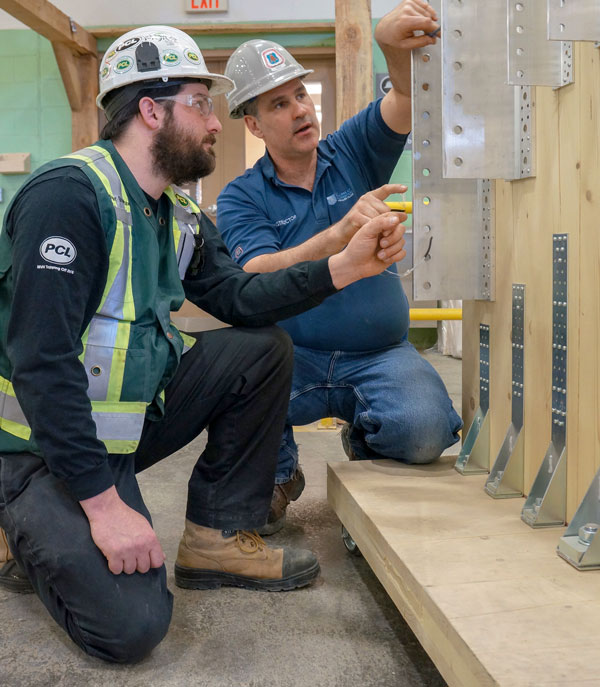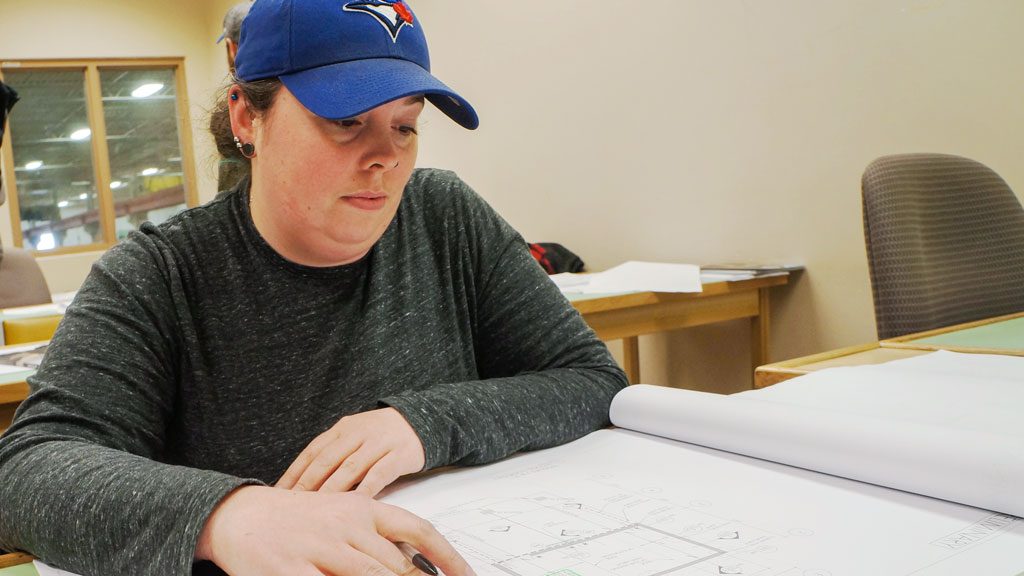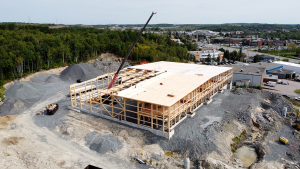Mass timber construction is still novel in the Greater Toronto Area but a raft of projects are in development and a pilot course teaching carpenters the ropes is up and running.
The four-week course uses full-scale building modules as a learning medium at the College of Carpenters and Allied Trades (CCAT) in Woodbridge, Ont. Covered is everything from the how-tos of timber framing tools and fastening systems to methods of installing prefabricated cross-laminated timber (CLT) walls and ceilings.
“It’s a fair bit different than any other construction,” says Jason Taylor, one of the course instructors at the CCAT.
Buildings are largely prefabricated in a plant and then shipped to site for carpenters to assemble.
In one portion of the course the nine students learn about panel loads and crane rigging capacity to prevent tip-over.
“There’s a lot of new hardware and it is important to install properly for the building to work as a unit,” adds Taylor, noting installation angle and spacing is critical for screws — some of which are 16 inches long.
The CCAT course was developed in response to a demand by contractors wanting to bring their crews up to speed to prepare for jobs in the promising new field.

Cristina Selva, executive director of the CCAT, says Ontario’s Ministry of Natural Resources and Forestry approached the college two years ago to develop the course “because nothing of this nature existed across Canada.”
Selva says last year the CCAT sent two of its instructors to work on a mass timber project in downtown Toronto because of the lack of tradespeople skilled in the assembly process.
Eight of the nine students in the pilot are journeypersons or fourth-year apprentices hand selected by their employer contractors to participate. One of those students is Amanda Howell who recently worked on a high profile five-storey mass timber office building in Toronto’s Liberty Village neighbourhood.
Employed by Timmerman Timberworks, she says the course covers all the bases.
Fellow student Kirk Johnson agrees.
Johnson, one of five journeyperson carpenters employed at PCL Construction who are taking the course, draws the analogy of the CLT panel assemblies as being “like a big Lego set. Everything is precut for you on a CNC machine (in a factory). It’s just a matter of flying it in and attaching it.”
It is hardly straightforward, however, he says, noting connections consist of many different engineered fasteners such as plates, nuts and bolts.
What’s more, if the foundation doesn’t meet the mass timber manufacturer’s specifications, adjustments to the structure are often required.
Shimming to level a foundation using steel plates is a case in point.
Taylor says making sure the foundation contractor “is reputable and follows blueprints so everything works from the bottom to the top” is paramount.
The CCAT instructor expects mass timber construction will catch on in the Greater Toronto Area.
“I’ve seen other products — ICF forms, for example — slow at first but then take off. I think you will see that happen here,” says Taylor.
Speed of erection and the environmental benefits of wood are reasons he is confident that mass timber construction won’t be a fad.
While mass timber is less labour intensive than other construction methods, industry observers say as the industry grows jobs will open up in fabrication plants.
Howell, who is a third-year apprentice, says the industry is bound to attract carpenters because working with wood, rather than steel or concrete, is a carpenter’s dream.
“It’s where we started,” she says.
“People are talking about this like a new technology but if you look at the old (19th and early 20th century) buildings in Liberty Village they are post and beam. We’re going back to traditional methods — just changing them a little to the new technologies we have today.”
As the mass timber industry picks up speed in Ontario, the CCAT will offer more courses, says Selva.
“It depends on the number of projects…how it takes off in the industry,” she says. “With the case of any new technology we like to get out in front…to be prepared for it.”









CCAT and the Carpenter’s Union Local 27, taking the lead and investing in the future of the industry. Great job.
This is a great article letting us know one of the directions the union is trying to set up and move towards. I also liked how it referenced looking forward in other words I liked that it shows that we are looking at what we can do in the future. Being a carpenter takes skills and this article points that out as well.